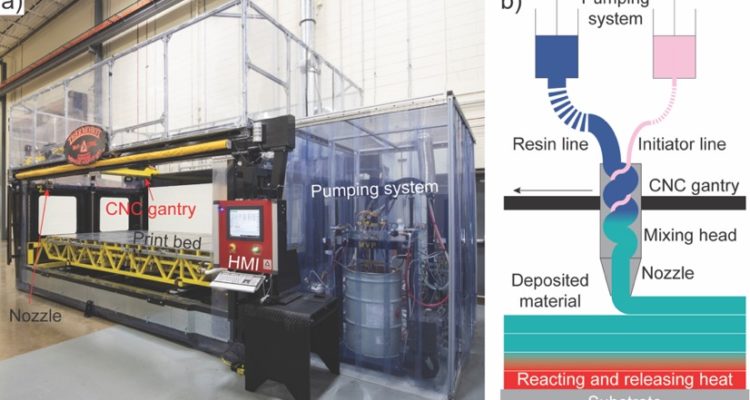Carbon fiber is often used to control warpage of 3D-printed thermoplastics as they cool and shrink. But fibers will align in the direction of print as they are extruded within a solid media, such as acrylonitrile butadiene styrene (ABS), polyethersulfone (PESU) and polyether ether ketone (PEEK). It is common to see a 60% to 80% decrease in mechnical properties with carbon fiber reinforced thermoplastics when comparing in-plane (X-Y) properties as opposed to out-of-plane (Z-direction) in thermoplastic print media, which is caused by fiber alignment. Z-direction strength has no fibers bridging the melted thermoplastic to thermoplastic beads.
With thermosets, beads are not melted together. They are deposited as a viscous liquid that flows together while also chemically reacting. This results in much improved inter-layer bond strength and mechanical properties. Thermoset medias are viscous liquids rather than molten solids and allow a greater degree of fiber movement, resulting in random orientation within the cured part. This results in more isotropic mechanical properties for thermosets versus thermoplastic anisotropy described earlier. Thermoset print media have reactive bonding sites, which leads to much stronger bond strength between layers and enables more isotropic prints.
Specific advantages of pumpable liquid print media, such as PRD, include the ability to start and stop a print for inclusion of items – such as metal inserts, reinforcing materials, core materials and cooling/heating lines – through a unique feature called “pick and place” on the RAM printer. Additionally, thermosets can print multiple sections at the same time, which can be bonded using the same print media to “glue” sections together, similar to how many composites today are built in sections or laminate layers to maximize perfomance characteristics, such as strength and stiffness. Support structures can often be eliminated by printing items out-of-plane, in 90-degree overhangs.
Advancements in additive manufacturing using thermoset print media continue. To date, most of the work has centered around tooling, specifically mold-making and fixtures. Part production will likely need to incorporate continuous fibers for improved strength and necessitate robotic 3D printers to deposit the fiber. Current development is focused on higher heat resistant materials, thermally conductive material and very low coefficient of linear thermal expansion (CLTE) materials for mold-making applications in particular.
Rick Pauer is applications specialist at Polynt Composites. Email comments to rick.pauer@polynt.com.
Disclaimer: Opinions, statements and technical information within the Tech Talk column are that of the authors. ACMA makes no warranty of any kinds, expressed or implied, with respect to information in the column, including fitness for a particular purpose. Persons using the information within the column assume all risk and liability for any losses, damages, claims or expenses resulting from such use.


